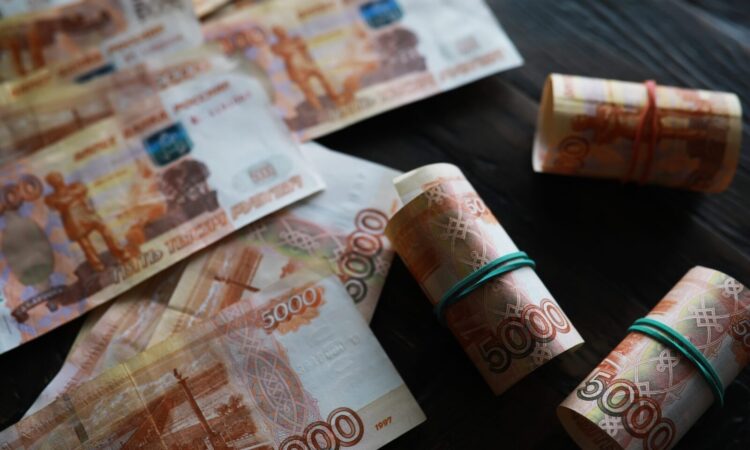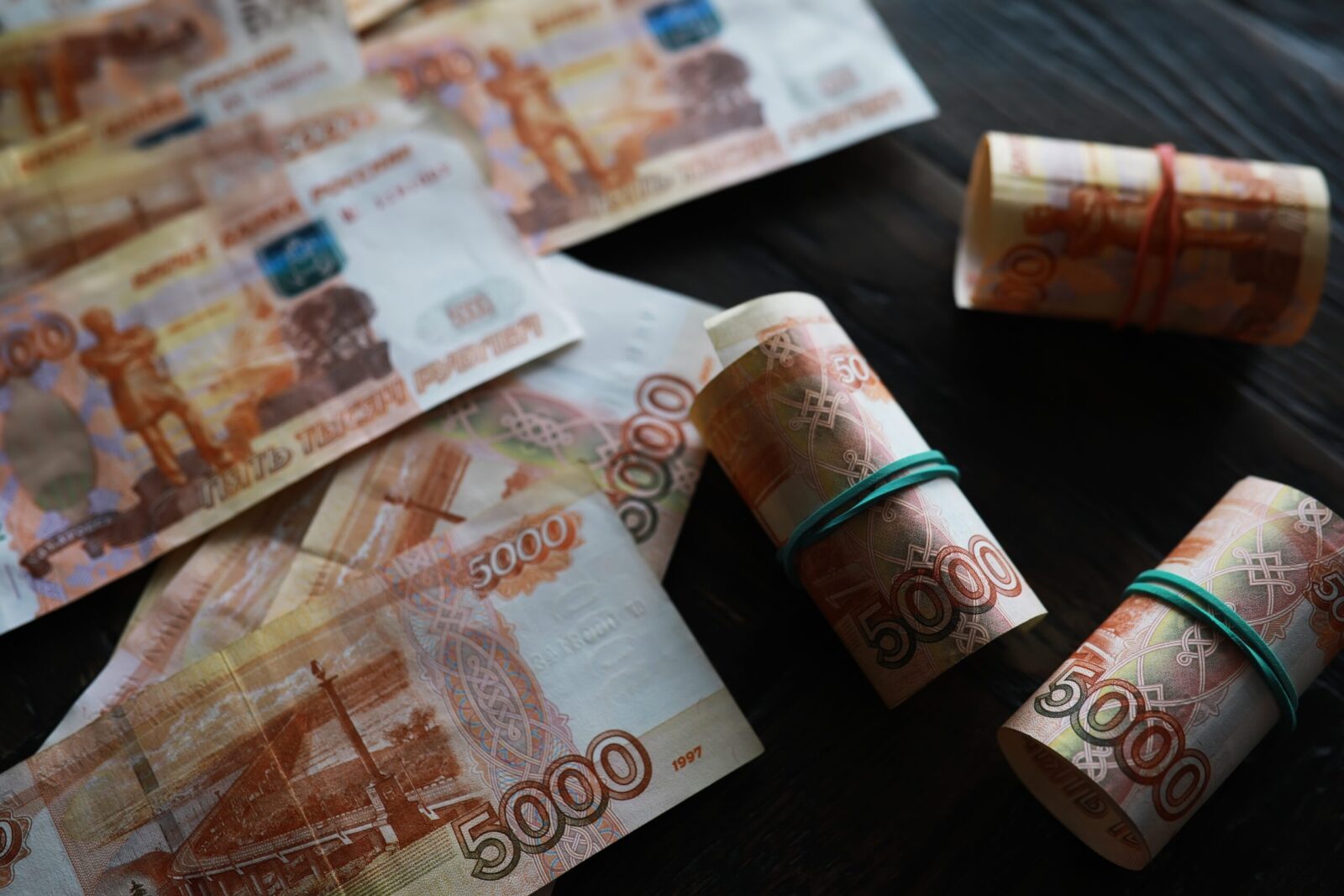
Russia’s war in Ukraine has resulted in grave consequences for the rouble. While an initial rise in value was originally viewed by Moscow as a sign of failing western sanctions, this boost is long gone. Moscow is now exploring various strategies to keep its troubled currency afloat.
October 23, 2023 –
Pitamber Kaushik
–
Articles and Commentary

Rouble notes. Photo: Alex Kich / Shutterstock
The Russian rouble experienced a significant decline in mid-August, slipping below the value of a single cent in US dollars. This marked its lowest value since the immediate aftermath of the Ukrainian invasion. Remarkably, the rouble has proven to be one of the most poorly faring currencies globally this year, surpassed in this dubious distinction only by chronically ailing currencies such as Venezuela’s bolivar. The following day, Russian monetary authorities found themselves compelled to intervene, a response not witnessed since the early days of the war. The Bank of Russia made the bold move of increasing interest rates by a substantial 3.5 percentage points, now standing at 12 per cent. Although this action did prompt a modest uptick in the rouble’s value, it remains significantly undervalued at 96 to the dollar, a stark contrast to its standing of around 60 at this time the previous year. It is worth noting that the prospects of these rate hikes swiftly curbing the rouble’s decline seem unlikely, which carries repercussions for Vladimir Putin’s capacity to sustain the ongoing conflict.
Typically, currency collapses are sparked by anxiety and unrest among international investors or the apprehensive flight of domestic capital in response to a crisis. However, trading activity surrounding the rouble, especially with the dollar, continues to be sparse. Russia’s isolation due to sanctions and capital controls has left it cut off from the global financial community. Rather than mirroring the collective sentiments of speculators, the rouble’s oscillations adhere to the conventional economic model. This reflects the relative influence of exports and imports.
Intriguingly, the imposition of a 60 US dollar price ceiling on Russian oil by the Group of Seven (G7) back in December has had a palpable impact. The value of Russia’s exports has experienced a sharp decline, with earnings in dollar terms for the period spanning from January to July this year registering a substantial 15 per cent decrease compared to the same timeframe in 2022. This conspicuous reduction in earnings cannot be solely attributed to the global decline in oil prices. At the same time, imports have surged, spurred on by the government’s vigorous prosecution of the ongoing war and its resulting procurement of essential goods. Consequently, Russia’s current account surplus, serving as a key metric for quantifying the surplus of foreign currency inflow over outflow, has plummeted by a staggering 86 per cent. This dwindled to a mere 25 billion US dollars within the first seven months of the year.
This situation presents a dual perspective. Firstly, it implies that the limitations imposed by the oil-price cap are indeed having a discernible impact, as efforts to circumvent this policy have proven ineffectual in offsetting the setbacks caused by the compulsion to sell oil at a discounted rate. Secondly, it hints at Russia being able to underhandedly source and import goods through alternative channels, a suspicion deepened by the notable swell in German exports to Russia’s more sympathetic neighbours.
The implications of a depreciated currency are twofold – it augments the rouble’s valuation for the government’s oil revenues, while simultaneously inflating the costs associated with imports. As an example, Russia’s Deputy Prime Minister Andrei Belousov posited in June that a valuation of 80 to 90 roubles per dollar would be most advantageous for his nation. This stance represented a noteworthy departure from an earlier narrative, in which the Russian government had conveniently seized upon a much stronger rouble as evidence of the futility of western sanctions. However, that aura of confidence has since dissipated. On August 14th, Maxim Oreshkin, one of Putin’s key advisers, penned a compelling column, emphasising the importance of a resilient rouble while attributing its catastrophic decline to the actions of their central bank.
The emergency hike in rates only provided marginal relief to the Russian currency. Given the hostile state’s global isolation, it is unlikely that elevated interest rates would attract speculative capital, such as high-risk short-term gain investments. Attention may thus shift to exit-prone domestic capital. Tightening and reinforcing capital control measures could potentially stem this tide but such measures would take time to yield results. The government is reportedly planning to convene to contemplate the prospect of mandating exporters to convert their foreign currency earnings into roubles.
Another alternative on the table is direct intervention in the currency markets. The central bank has systematically cut down on buying foreign currency across borders. In accordance with a prior budgetary rule, Russia used to trade roubles for other currencies when it had an excess of inflows from fossil fuel sales, with the aim of amassing reserves. However, this norm was forsaken on August 9th. Official data indicates that Russia possessed close to 600 billion US dollars worth of foreign-currency reserves at the beginning of last month, indicating that the central bank possesses fuel to power up its plummeting currency. However, a little over half of these reserves are currently frozen due to western sanctions.
The government faces a critical decision if it is not able to secure more oil soon. The state could curtail spending, including reductions in its military expenditure, in order to mitigate imports. The other option would be for the burden to fall upon the civilian economy. Rising inflation and elevated interest rates would erode the purchasing power of ordinary Russians, compelling them to reduce their consumption of foreign goods. Consequently, the trajectory of Russia’s economy will not be determined by the judgments of international financiers but by the extent of Putin’s assertiveness, stubbornness and belligerence. It goes without saying that this is indeed a deeply disconcerting predicament to find oneself in.
Pitamber Kaushik is a writer, journalist, columnist and independent researcher based out of Jharkhand, India. His articles have appeared in over 280 publications across 60+ countries. He has previously written for the Austrian Economics Centre, New Humanist Magazine, Asia Times, Helsinki Times, The Telegraph India, and Gulf News, among others.
Please support New Eastern Europe’s crowdfunding campaign. Donate by clicking on the button below.



